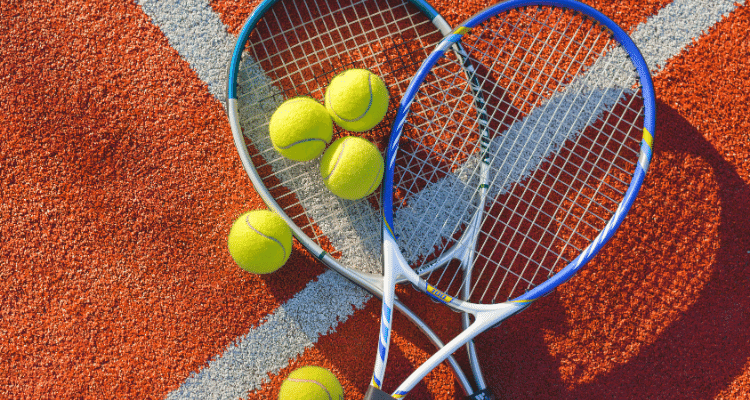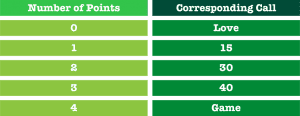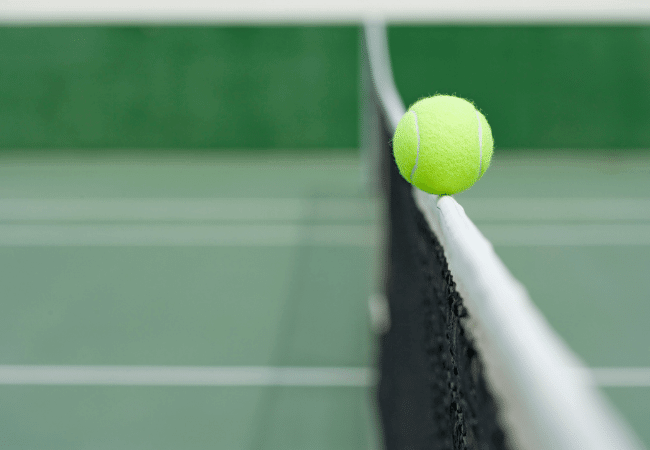If you are new to the world of tennis, the jargon can seem somewhat intimidating. There’s so much vocabulary that may not be immediately understood. The sport certainly has its own culture.
For those who barely understand the rules, a tennis court may seem like an unwelcoming place.
While the sport and culture may seem uninviting to outsiders, at its core, tennis is a fun sport that can and should be enjoyed by all.
Most beginners find that more experienced players welcome newcomers and are more than willing to offer pointers and feedback to those that also share a passion for the sport.
One of the areas where beginners have the most trouble is understanding the tennis terminology used. After all, even the scoring system uses confusing terms like “love”.
To break down some of these barriers and help you better understand tennis and its culture, below are some of the most common terms you are likely to hear on a tennis court.
Contents
Tennis Terminology: Equipment

Tennis Racket
The term tennis racket/racquet is mostly self-explanatory. It is the primary tool used to play the game. Traditional tennis rackets were almost always made from wood and featured much slimmer profiles than their modern equivalents.
Today, rackets are made from much lighter and more responsive composite materials, such as graphite, high-density plastics, titanium, Kevlar, and even fiberglass.
Tennis Ball
This term is quite obvious. It is worth noting that there are several different types of tennis balls. Each ball is used for various purposes:
Regular Duty Balls – For clay and indoor courts, use regular duty balls. These are designed for playing on clay and indoor courts. They have softer felt exteriors, which are ideal for softer courts, but rarely last on hard court surfaces.
Extra Duty Balls – Extra duty balls are for hard surfaces. The woven felt can withstand more punishment, which is why they are used on the rougher surfaces of outdoor hard courts.
High Altitude Balls – These pressurized tennis balls are specifically designed for use at altitudes of 4,000 feet and above.
Practice Balls – Practice balls tend to be lower in quality and are meant to be used for practicing swings, serves, and other techniques. They are much firmer than balls designed for gameplay, which is why they last much longer.
They are also much less expensive and can usually be purchased in bulk. There are also pressureless practice tennis balls, which are very inexpensive and great for those just trying to learn the basics of swing mechanics or for use with a ball machine.
Tennis Shoes – The term tennis shoe does not refer to any footwear you put on your feet while playing tennis. They are specially made shoes made with the stability, support, and grip required to play tennis safely.
They tend to be much stiffer than the shoes worn for other sports. It is because they are specifically designed to support the rapid forward, backward, and lateral movements that are necessary for tennis.
If you’re in the market for men’s tennis shoes, women’s tennis shoes or wide tennis shoes, they exist – thankfully!
Tennis Terminology: The Court

Tennis Court – The term tennis court refers to the entire area where the sport is played. The surface of a tennis court can be made from a variety of materials, including clay, grass, tile, cement, and asphalt.
Net – The net is the divider that separates either side of the tennis court. It should be as level as possible. The mesh should be free from tears.
Baseline – The baseline is the line at the back of either end of the court. It runs parallel to the net and defines the point you cannot cross when hitting a serve. It is also the rear boundary that the ball cannot cross when you are returning.
Service Box – The service boxes are the two boxes on either side of the net. When serving, you must place the ball in the opponent’s court (service box) which is opposite from where you are standing. Since you always start on the right, the first serve of each game should land in the opponent’s service box to your left.
Service Line – The rear line that marks the edge of the services boxes is known as the service line. It is the border of the services boxes that is furthest from the net.
Doubles Alley – These are the two pairs of sidelines marked on each side of a tennis court. They mark the outer boundaries of the court when you are playing singles or doubles. For doubles matches, the outer line is used to mark the boundary. In singles matches, the inner lines mark the boundary of the singles court. The area between the two lines is the alley.
Tennis Terminology: Scoring

Points – Scoring points is the aim of tennis. They are won in multiple ways. You can win a point or your opponent can lose a point – regardless of who starts the point.
Tennis points are as follows:
- Love – Tennis-specific term for zero
- 15 – The first point
- 30 – The second point
- 40 – The third point
- Game – The fourth point
For more info about tennis scoring, check out this post.
Deuce – Deuce is a term used to describe a tied game when both sides are at 40. To reach a score of 40 – 40, or 40 – All, both sides would have won three points and the score could then be described as deuce.
Advantage – Advantage, or ad for short, refers to a point scored after deuce. If the player serving the ball scores a single point, it is known as Ad-in, meaning they have the advantage. If the player receiving the serve scores a point, it is Ad-out, meaning they now have the advantage.
The Deuce and Advantage cycle continues until one side wins two consecutive points (the advantage and the next point) to win the game.
Game – A game consists of one player winning at least four points (if no deuce).
Set – A set is a series of games. Often, they are only six games, but if the players tie at five games each, the set will usually become a first to seven contests. If the games in a set continue to tie and the score reaches 6-6, a tiebreaker ensues.
Match – A match is a name for the scored competition between two opponents. In most cases, they are decided by a best of three or five sets.
Other Tennis Terms You Should Know
Now that you are familiar with some of the basic terms, we will go over some of the other terms and phrases you are likely to hear on a tennis court:
Ace – This is when a served ball makes no contact with the opponent’s racket. A point is still scored. These points usually involve a perfectly placed and powerful serve.
Ad-Court – This is a term for the left side of the tennis court. Ad/advantage points are always played from the left side.
All – All is used to describe an even score. For example, if someone said the score was 30 – All, that would mean each player had won two points and the score was 30 for both. The same term describes the number of games won, meaning if each competitor had won three games, 3-All describes it.
Approach Shot – A tennis shot that players hit so they can move towards the net. Sometimes they are planned (offensive) and other times they are not (defensive). If an opponent likes being at net, approach shots are used to transition themselves from the baseline to the net. Many players are not fans of playing at the ent. If their opponent hits a short ball and draws them in, an approach shot might be used out of necessity.
Backcourt – This is the area towards the back of the court. While it is a bit of a general term, it usually refers to the area defined by the service line and the baseline.
Backhand (Groundstroke) – This is one of the main types of swings players use to hit the ball. As the name suggests, it involves returning the ball by swinging the racket around one’s body with the back of the hand preceding the palm.
The swing is with one or two hands on the racket, and it is often used to generate a significant amount of power.
Backspin – When the ball is hit in a way that causes it to rotate backward. Backspin usually causes the ball to drop abruptly. Putting backspin on the ball is a fantastic way to place an accurate drop shot.
Break of Serve – When a game is won by the player returning the serve, rather than the player serving. Serving is considered to be an advantage. If you don’t win your service games, you’ve been broken.
Coaching Violation – According to the official rules for the Grand Slam Tennis Tournaments: “Players shall not receive coaching during a match, including during the warm-up phase. Communications of any kind, audible or visible, between a player and a coach may be construed as coaching.” The rules are not as strict with team tennis and league play, but if watching tv on tennis and you hear the umpire warn a player about a coaching violation, you’ll understand the reasoning behind it.
Doubles – Doubles refers to a tennis match that is played with four players. Two players are on each side of the court. While doubles can be very competitive, it’s a nice way to incorporate a “team” to a usually solitary sport.
Double Fault – A player has two attempts to start of a point with their serve. If both attempts at serving fail, it is known as a double fault and the opposing player is awarded a point. The term fault simply refers to an error during a serve attempt. The ball has not landed within the bounds of the opposing player’s service box or the served ball was blocked by the net.
Drop Shots – A drop shot is a ball that is designed to land near the net on the opposing player’s side of the court. Drop shots are usually hit with a lot of backspin and are similar to a bunt in baseball – they’re often unexpected. They are somewhat difficult to pull off, but if time correctly, using a drop shot can be an excellent way to outwit your opponent to win a point.
Foot Fault – A foot fault is a fault that occurs when the serving player has stepped on or over the baseline with either of their feet while serving the ball. When serving, both feet need to stay behind the baseline. A foot fault is the same as any other type of fault, so two of them would result in a loss of a point.
Forehand (Groundstroke) – A stroke where the palm of the dominant hand is facing forward when the ball is struck. Forehand groundstrokes are hit from the back of the court. If a forehand is hit near the net with the ball not bouncing, it’s referred to as a volley.
Let – A point that is replayed due to interference. Can also refer to a serve that hits the top of the net but is otherwise good. The serve is retaken, but it does not count as a fault.

Lob – Hitting the ball in a way where it is lifted high in the air rather than just over the net. Often, these shots are used to lift the ball over the opponent when they are close to the net.
Match Point – When you only need one more point to win the entire match.
Rally – A series of back-and-forth hits between players where the ball stays in play. At the professional level, it isn’t unheard of for rallies to reach 10 or 20 strokes during one point.
Serve – Short for service, it’s the act of hitting the ball into play. It usually occurs as an overhead motion and is viewed as an advantage when playing.
Slice – A shot that puts significant backspin on the ball by making contact with the racket in a high-to-low motion.
Smash / Overhead – A powerful overhead shot that sends the ball towards the opponent at a fast pace. Similar to a serve, but it can originate from anywhere on your side of the court. As long as the ball is within the boundaries of the court (playing singles or doubles), it’s in.
Volley – A shot made during play before the ball has touched the surface of the court. Volleys usually occur close to the net, but they can occur from anywhere in the court. A player can take the ball out of the air at any point, but that isn’t a high percentage shot.
Final Words
Do not worry about memorizing each of these tennis terms. While it is a good idea to familiarize yourself with proper tennis terminology, they’ll come to you naturally the more you play.
If you do not know what a term means, do not be embarrassed to ask. Another good way to better understand the sport and its terminology is to watch professional tennis matches on television.
Most importantly, remember that everyone must start somewhere. Get out there and have fun!

